DEARBORN, Mich. — New video footage of a fire involving a Ford F-150 Lightning this year highlights a growing concern around electric vehicles: volatile fires from the batteries that power them.
.
The previously unreleased footage, which CNBC obtained through Michigan’s Freedom of Information Act from the Dearborn Police Department, shows smoke billowing from three tightly packed electric pickups in a Ford Motorholding lot in Dearborn, Michigan.
Moments later, flames shoot several feet above the vehicles, which were unoccupied. It wasn’t clear based on public documents and police video how long the fires burned.
.
Experts say EV fires can take hours, rather than minutes, to extinguish..EV fires have become a growing concern as automakers push to increase sales of electric vehicles and meet tightening emissions standards.
.
The Biden administration has set a target for half of new vehicles sold in the U.S. by 2030 to be electric. Automakers are spending billions of dollars to electrify their lineups. However, there’s been little to no discussion about first responder training for when the vehicles catch fire, whether due to a malfunction or, more commonly, a crash.
.

The Feb. 4 holding lot fire at Ford’s Rouge Electric Vehicle Center in Dearborn prompted the company to quickly halt production of the new pickup for five weeks.
.
The automaker also recalled 18 of the vehicles already-delivered to consumers, which Ford has likened to the Model T in terms of importance to the company.
.
Ford identified the root cause as related to battery cell production made by supplier, SK On.
Police officers responding to the blaze described the vehicles as being “engulfed in flames” and can be heard on video worrying that the vehicles could “blow up.”
.
Lithium-ion batteries, commonly used in EVs, can be volatile and extremely difficult to put out once on fire.
“We’re not putting this f---er out. Look at it,” said one responding officer during the February F-150 Lightning fire.
.
First responders can be heard on video expressing concern about how much water is needed to put out EV fires and whether a special foam would be required.
.
They also questioned the viability and safety of electric vehicles.
“They have to put like a whole f---ing lake (Erie) on it to put them out,” the same officer said during the Feb. 4 event.
.
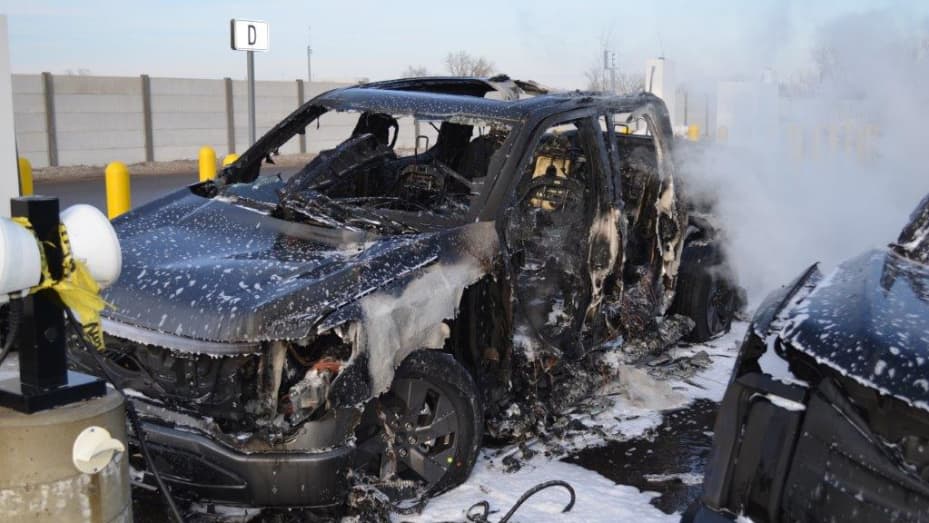
.
The footage obtained by CNBC totaled about two hours of video, including overlapping footage, from 17 police body-cams and vehicle dash-cams between 3:36 p.m. and 4:22 p.m. ET, according to time stamps on the bodycam videos.
.
Photos obtained from Dearborn Police through a separate Michigan FOIA request show the aftermath of the blaze.
.
One of the three vehicles is barely recognizable, with its body nearly melted down to the ground. The two neighboring vehicles were also heavily damaged.
.
“There was only one [vehicle on fire] when we got here. They’re catching. It’s these frickin’ batteries,” that same responding officer said, according to the footage.
.
The F-150 Lightning fire occurred while the vehicle was charging in a holding lot during a pre-delivery quality check.
.
It was caused by an internal short circuit, due to a manufacturing issue when cells in the battery were at a high state of charge, according to public documents associated with the recall.
.
Ford said engineers determined there was no evidence of a charging fault.
.
“Together with SK On, we confirmed the root causes and swiftly implemented quality actions,” Ford said in a statement to CNBC.
.
“The Rouge Electric Vehicle Center has been back up and running since March 13 and is back to full production and shipping vehicles to customers.”.
.
The fire added to ongoing quality and execution issues that have plagued the automaker as it attempts to restructure its business and position itself better for EVs.
.
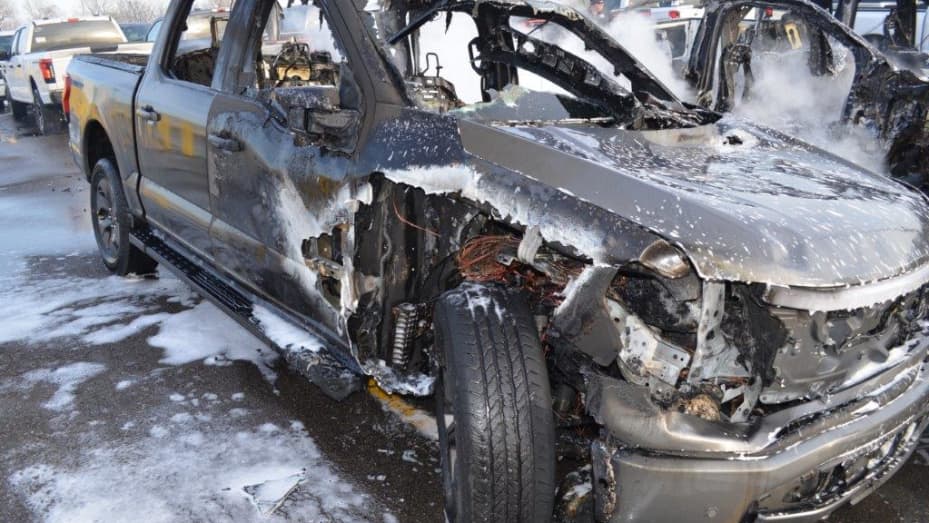
Vehicle fires are not new. They regularly occur in traditional vehicles with internal combustion engines.
.
But the fires in EVs, such as the F-150 Lightning, and their batteries, are increasingly worrying for first responders across the country, in part because they involve a chain reaction between battery cells known as thermal runaway.
.
Such fires also are a growing problem for automakers, who could lose the momentum they’ve built with car buyers and climate-conscious lawmakers, if the risk continues shaking public confidence in the technology.
.
Fires involving EV batteries can burn hotter and longer and require new techniques to extinguish.
.
A report from the Dearborn Fire Department, which responded to the February Lightning fire, said one of the vehicles was determined to be “un-extinguishable” and firefighters had to contact a colleague with “expertise in EV technology” on what to do.
.
“This is a big issue globally,” said Michael O’Brian, board member of the International Fire Chiefs Association, who leads fire and life safety.
.
“We need to better understand what the best processes are through testing and evaluation with real firefighters.”
.
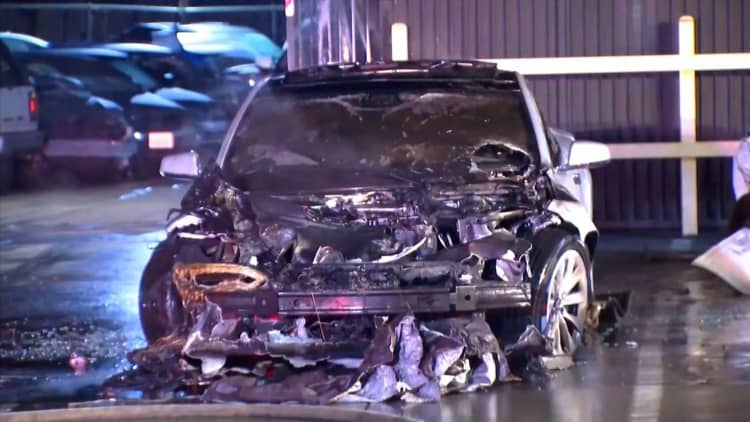
EVs are powered by a series of battery cells inside an airtight pack that’s designed to prevent any substances from passing in or out.
.
The packs also are mainly built into the underbodies or frames of the vehicles, a spot that can be difficult for first responders to reach.
.
Even if they could easily access the cells, the “fire” is actually a chemical reaction and far more difficult to handle than a traditional gasoline fire.
.
“You’re now dealing with a vehicle that doesn’t work like anything else you’ve been taught,” said David Dalrymple, a volunteer firefighter in New Jersey, who owns a first response training and consulting business called RoadWay Rescue.
,
“It’s a totally different animal. ... The primary goal is to cool it down to take away that chemical reaction heat.”
.
Dalrymple, who also serves on a Society of Automotive Engineers committee focusing on EV fire issues and standards, noted some other countries allow first responders to look up what hazardous materials are in a vehicle based on the license plate.
.
A similar system could be useful in the U.S., he said.
.
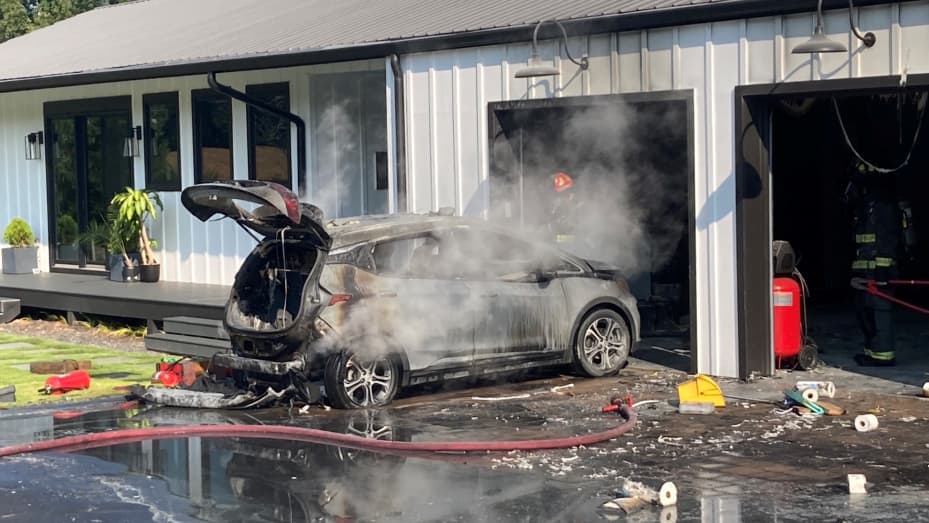
.
Experts are still trying to determine EV fire incident rates; the data is difficult to collect from disparate fire departments.
.
Vehicle fires involving internal combustion engines are far more common than EVs, however experts expect that to continually even out as more electrified vehicles are sold.
.
Problems with plug-in vehicles that use such batteries have led automakers including Ford, General Motors, Hyundai and Porsche to recall models.
.
GM had to recall all of its 2020 and 2021 electric Chevrolet Bolt models built up to that point, due to a battery issue that resulted in several reported fires. See URL
.
As a result, GM expanded an ongoing nationwide program to educate public safety, fire and emergency service providers on how to most effectively handle emergency situations involving electric vehicles.
.
The state of Virginia has taken it upon itself to train firefighters. A bill that requires them to complete a training program about the risk of electric vehicle fires passed unanimously this year.
.
Trial by fire
.
Firefighters increasingly are facing the challenges created by EV fires.
.
This is made more complicated by what some experts say is a lack of regulations and standards, which allows automakers to do as they like regarding the design and rollout of EVs.
.
For more than a century, first responders have quite easily extinguished vehicle engine fires by popping the hood and drowning the area in water. That playbook doesn’t work with EVs.
.
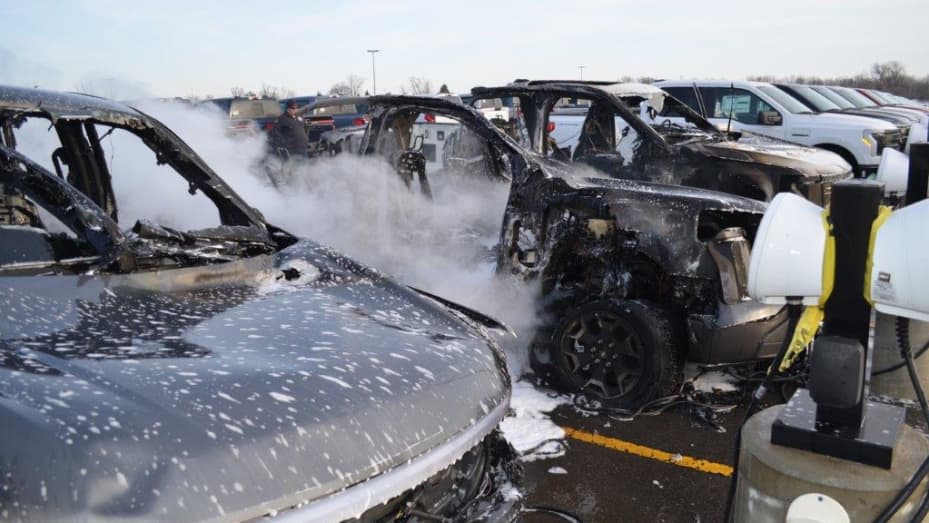
Each vehicle is unique and may require different techniques to extinguish, which means there are no set standards for putting out an EV fire.
.
Current best practices for an EV fire, depending on who you speak with, include submerging the vehicles in water, piercing the battery pack and inundating it with water, disabling a vehicle’s 12-volt circuit, or simply letting the fire burn until it’s out, emitting chemical toxins into the air.
.
O’Brian, a fire chief in suburban Brighton outside of Detroit, said the bigger the battery, the higher the concern for first responders.
.
He also noted that new battery plants to produce the cells for the vehicles often cost billions of dollars, highlighting what he saw as comparatively little funding being directed to the training of fire departments.
.
“I continue to keep advocating that both state and federal government needs to truly invest within the fire service on this topic for training, best practices, lab time,” O’Brian said.
.
“It’s as simple as what’s the best way to turn up your efforts when exposed to lithium-ion off-gassing” when the vehicles catch fire.
.
O’Brian said once the thermal runaway starts there’s really no putting the fire out unless you stop the chain reaction of lithium-ion cells from overheating.
.
It’s unclear how many, if any, people have died from an electric vehicle spontaneously catching fire.
.
There have been reports of fatal fires following crashes, but many times EVs have caught fire when charging and unoccupied.
.
There’s also the risk of reignition: Lithium-ion battery fires can re-ignite weeks later with little to no warning. .
.
The Sacramento Metropolitan Fire District responded to such an incident last year involving a Tesla that had been in an accident three weeks prior.
.
Once the F-150 Lightning fire was under control on Feb. 4, Ford had security monitoring the vehicles throughout the night in case they become “reignited again,” according to the Dearborn Fire Department report.
.
William Lerner, an independent safety tech inventor and delegate for the International Organization for Standardization, said best practices would call for a three-week monitoring period after a fire, with particular attention during the first 24 hours.
.
Lerner, who works closely with first responders and their trainers, expressed concern that first responders may not have the appropriate personal protection and safety equipment to handle the fires. He said the equipment used for a traditional vehicle fire may not suffice.
.
“The whole way of dealing with this is completely different,” he said. “The only similarities are they have four wheels, and they look like cars. It’s a completely different product, and that’s the problem.”
.
Ford, in its Emergency Response Guide for the 2022 Lightning, broadly details some issues about the potential for reignition in the event of a fire and suggests storing the vehicle outside or at least 50 feet away from other objects.
.
It does not offer a solution for putting out a battery fire other than “LARGE amounts of water” or using a “Class ABC powder-type extinguisher to contain and smother the flames.”
.
Ford said the company “took part in an information-sharing session on how to handle battery fires in summer 2022 with members of the Dearborn fire department.”
.
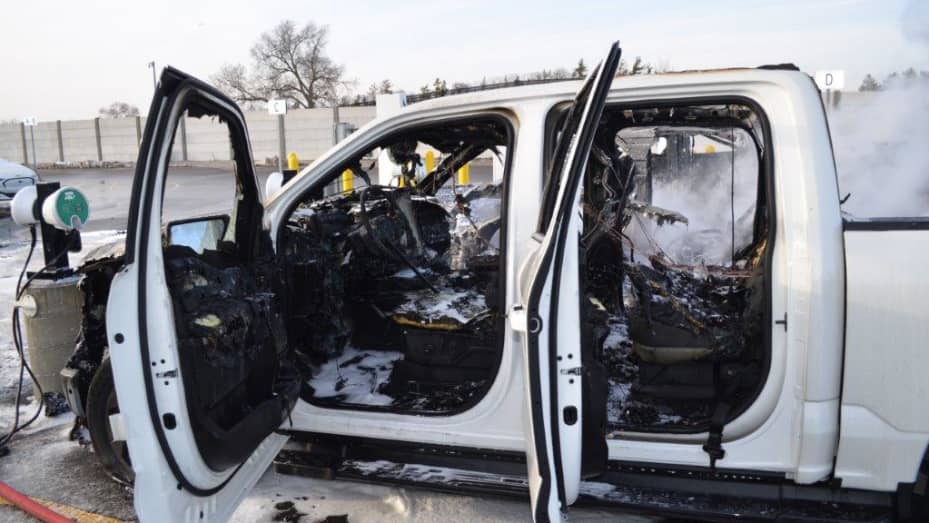
.
“We continue to look at opportunities to help educate on this topic,” the automaker said.
.
Dearborn Police Chief Joseph Murray declined to comment about the Feb. 4 F-150 Lightning fire or any training his department has done for EVs.
.
Experts say such training for first responders is a start, but it needs to be constantly updated and rolled out. .
.
There are also concerns about the manpower and ability of fire departments to handle EV fires, according to several officials.
.
Not to mention the dire circumstances they may be dealing with involving vehicle occupants, which are their first priority.
.
“When you have an EV fire, you don’t have the time to stop and look through an emergency response guide Lerner said.
.
“You’ve got human beings in there that can die. So, you may not have one second to waste in order to get
these human beings out.”
APPENDIX
CHEVY BOLT CATCHES FIRE WHILE CHARGING ON DRIVEWAY IN VERMONT
https://www.windtaskforce.org/profiles/blogs/chevy-bolt-catches-fir...
THETFORD; July 2, 2021 — A fire destroyed a 2019 Chevy Bolt, 66 kWh battery, battery pack cost about $10,000, or 10000/66 = $152/kWh, EPA range 238 miles, owned by state Rep. Tim Briglin, D-Thetford, Chairman of the House Committee on Energy and Technology.
He had been driving back and forth from Thetford, VT, to Montpelier, VT, with his EV, about 100 miles via I-89
He had parked his 2019 Chevy Bolt on the driveway, throughout the winter, per GM recall of Chevy Bolts
He had plugged his EV into a 240-volt charger.
His battery was at about 10% charge at start of charging, at 8 PM, and he had charged it to 100% charge at 4 AM; 8 hours of charging.
Charging over such a wide range is detrimental for the battery. However, it is required for “range-driving”, i.e., making long trips. See Note
NOTE: Range-driving is an absolute no-no, except on rare occasions, as it would 1) pre-maturely age/damage the battery, 2) reduce range sooner, 3) increase charging loss, and 4) increase kWh/mile, and 5) increase the chance of battery fires.
Charging at 32F or less
Li-ions would plate out on the anode each time when charging, especially when such charging occurred at battery temperatures of 32F or less.
Here is an excellent explanation regarding charging at 32F or less.
https://electronics.stackexchange.com/questions/263036/why-charging...
Fire in Driveway
Firefighters were called to Briglin’s house on Tucker Hill Road, around 9 AM Thursday.
Investigators from the Vermont Department of Public Safety Fire and Explosion Investigation Unit determined:
1) The fire started in a compartment in the back of the passenger’s side of the vehicle
2) It was likely due to an “electrical failure”. See Note
NOTE: Actually, it likely was one or more battery cells shorting out, which creates heat, which burns nearby items, which creates a fire that is very hard to extinguish. See Appendix
https://www.vnews.com/Firefighters-put-out-blaze-in-car-of-Vt-State...
https://www.engadget.com/gm-chevy-bolt-fire-warning-215322969.html
https://electrek.co/2020/11/13/gm-recall-chevy-bolt-evs-potential-f...
GM Recall of Chevy Bolts
In 2020, GM issued a worldwide recall of 68,667 Chevy Bolts, all 2017, 2018 and 2019 models, plus, in 2021, a recall for another 73,000 Bolts, all 2020, 2021, and 2022 models.
GM set aside $1.8 BILLION to replace battery modules, or 1.8 BILLION/(68,667 + 73,000) = $12,706/EV.
https://insideevs.com/news/524712/chevrolet-bolt-battery-recall-cost/
https://thehill.com/policy/transportation/568817-gm-expands-bolt-ev...
Owners were advised not to charge them in a garage, and not to leave them unattended while charging, which may take up to 8 hours; what a nuisance!
I wonder what could happen during rush hour traffic, or in a parking garage, or at a shopping mall, etc.
Rep. Briglin heeded the GM recall by not charging in his garage. See URLs
https://www.ericpetersautos.com/2021/09/16/electric-social-distancing/
https://www.windtaskforce.org/profiles/blogs/some-ne-state-governme...
NOTE:
- Cost of replacing the battery packs of 80,000 Hyundai Konas was estimated at $900 million, about $11,000 per vehicle
https://insideevs.com/news/492167/reports-lg-chem-cost-hyundai-batt...
- EV batteries should be charged from 20 to 80%, to achieve minimal degradation and long life, plus the charging loss is minimal in that range
- Charging EVs from 0 to 20% charge, and from 80 to 100% charge:
1) Uses more kWh AC from the wall outlet per kWh DC charged into the battery, and
2) Is detrimental to the battery.
3) Requires additional kWh for cooling the battery while charging.
- EV batteries must never be charged, when the battery temperature is less than 32F; if charged anyway, the plating out of Li-ions on the anode would permanently damage the battery.
https://www.energy.gov/eere/articles/how-does-lithium-ion-battery-work
.
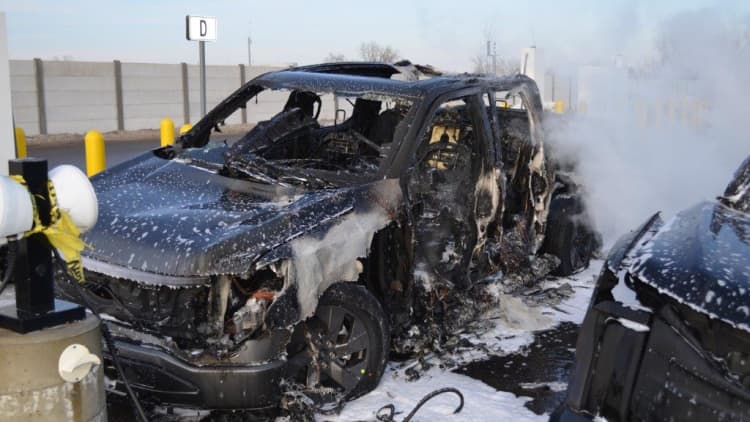
You need to be a member of Citizens' Task Force on Wind Power - Maine to add comments!
Join Citizens' Task Force on Wind Power - Maine